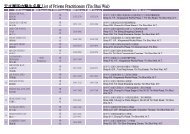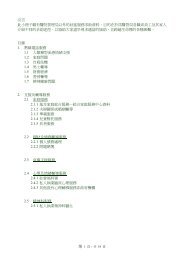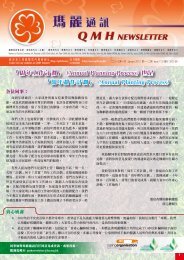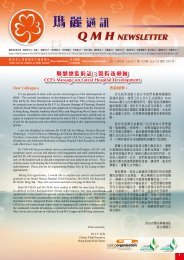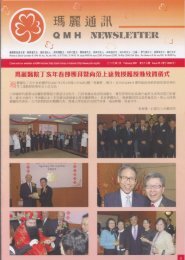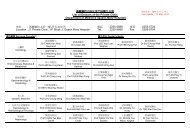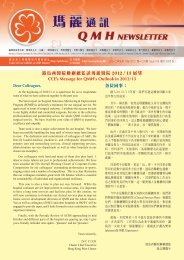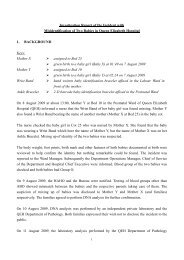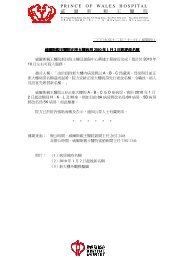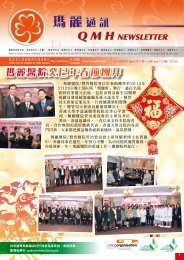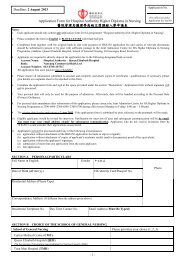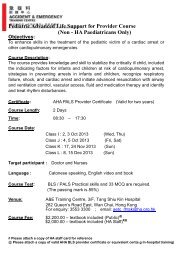2005 Edition Report on Drug Administration Procedure & Practices ...
2005 Edition Report on Drug Administration Procedure & Practices ...
2005 Edition Report on Drug Administration Procedure & Practices ...
Create successful ePaper yourself
Turn your PDF publications into a flip-book with our unique Google optimized e-Paper software.
Electr<strong>on</strong>ic prescribing (Medicati<strong>on</strong> Order Entry -- MOE)4.27 Discharge and home leave prescripti<strong>on</strong>s can be prescribed through the Medicati<strong>on</strong> OrderEntry (MOE) system. While electr<strong>on</strong>ic prescripti<strong>on</strong>s improve legibility and remove theambiguity of orders, this should be developed in the in-patient secti<strong>on</strong> (In-patient MOE).Verbal Orders4.28 Only in emergency and approved circumstances may a verbal order be given if the doctor isunable to attend pers<strong>on</strong>ally. The instructi<strong>on</strong> may <strong>on</strong>ly be accepted by an Enrolled orRegistered nurse who must immediately record the instructi<strong>on</strong> in the patient’s MAR andannotate it a ‘verbal order’.4.29 After the instructi<strong>on</strong> has been written, it must be READ BACK to the doctor checking thepatient’s identity, drug name, dosage, frequency and method of administrati<strong>on</strong>. It is theresp<strong>on</strong>sibility of the doctor giving the verbal order to ensure the correct interpretati<strong>on</strong> of theverbal order.4.30 The nurse receiving the message must, after following the normal checking procedure,administer the drug and pers<strong>on</strong>ally give both verbal and written instructi<strong>on</strong>s to the nursestaking over from him/her.4.31 A verbal order must be c<strong>on</strong>firmed in writing by the doctor c<strong>on</strong>cerned as so<strong>on</strong> as possibleand within 24 hours at the latest [refer to Pharmacy & Pois<strong>on</strong>s Regulati<strong>on</strong>s, Cap. 138A,Secti<strong>on</strong> 23(4)].4.32 Dangerous <strong>Drug</strong>s should not be ordered through verbal orders (refer to Dangerous <strong>Drug</strong>sRegulati<strong>on</strong>s, Cap. 134A, Secti<strong>on</strong> 3).Patient’s Own Medicati<strong>on</strong>s4.33 Patients should always be asked if they have brought any medicati<strong>on</strong>s into hospital withthem. To prevent unauthorised self-administrati<strong>on</strong>, brought-in medicati<strong>on</strong>s should be takeninto safe custody by the nursing staff and shown to the doctor and/or pharmacist.4.34 The patient’s own medicati<strong>on</strong>s should not normally be administered in hospital unless theyhave been positively identified, specifically prescribed by the doctor and when supplies arenot immediately available from hospital sources. The general practice of allowing patientsto c<strong>on</strong>tinue their own brought-in medicati<strong>on</strong>s without verificati<strong>on</strong> should not be encouraged.(Identificati<strong>on</strong> of medicati<strong>on</strong>s currently used in the HA may be searched by the TabletIdentifier <strong>on</strong> HA intranet http://cpointra/tabident.php;Registered Pharmaceutical in H<strong>on</strong>g K<strong>on</strong>g may be searched <strong>on</strong> the website of Department ofHealth http://www.info.gov.hk/pharmser/Reg_ir/download_pharm.html)4.35 The protocol / logistics for identificati<strong>on</strong>, prescribing and administrati<strong>on</strong> of brought-inmedicati<strong>on</strong>s to patients should be endorsed by the hospitals’ DTC.25




